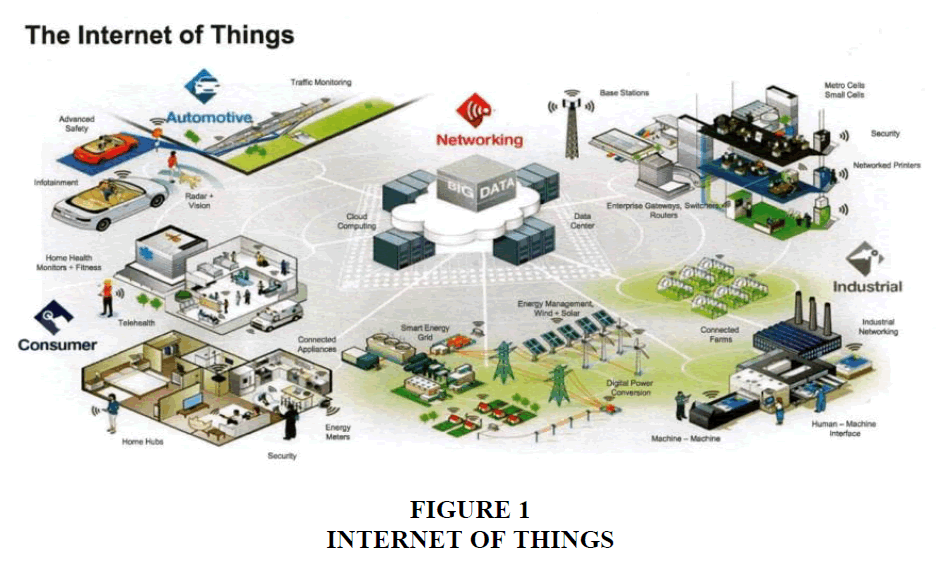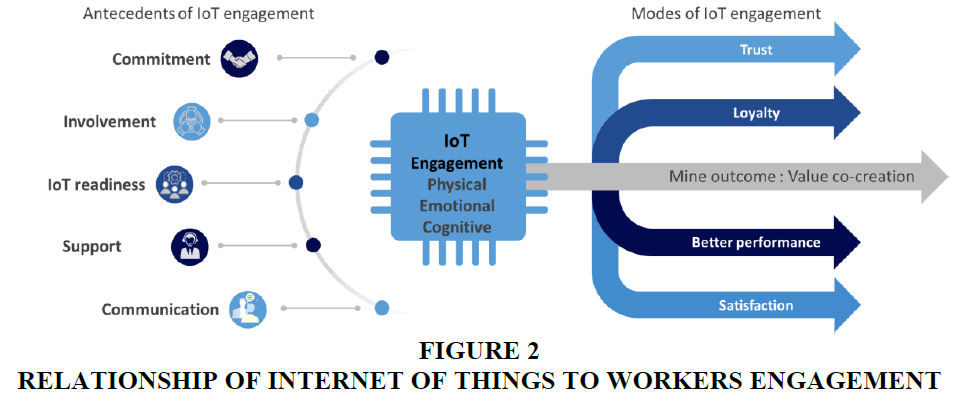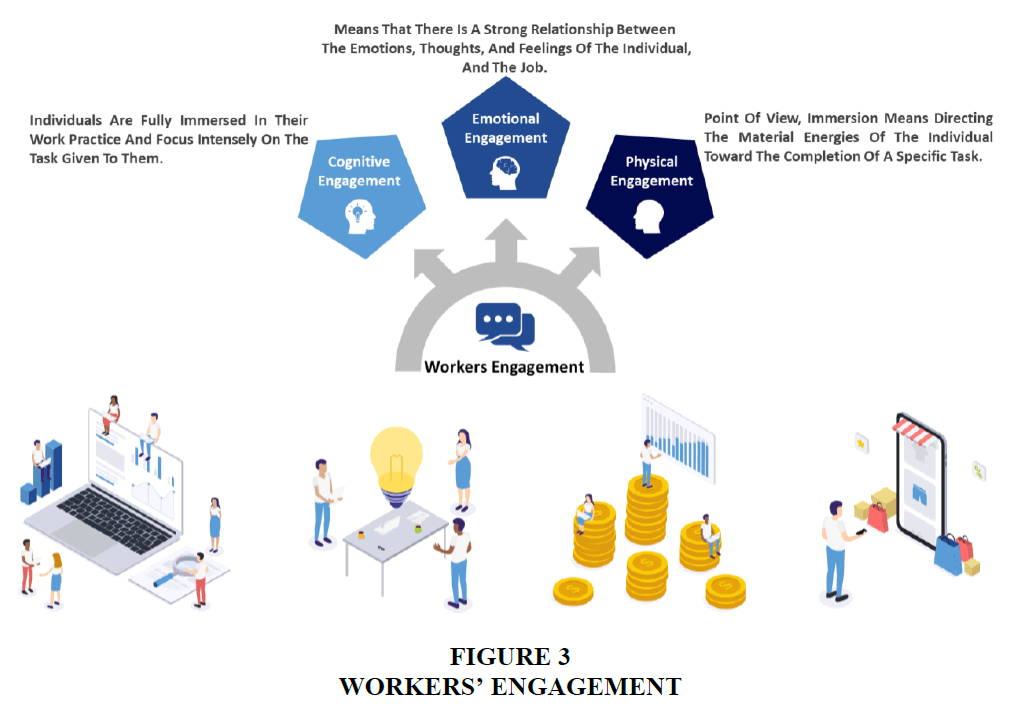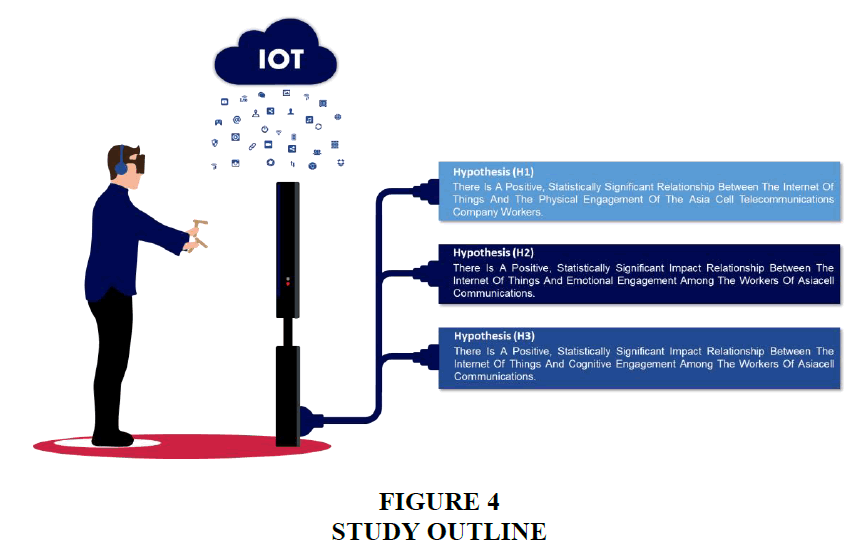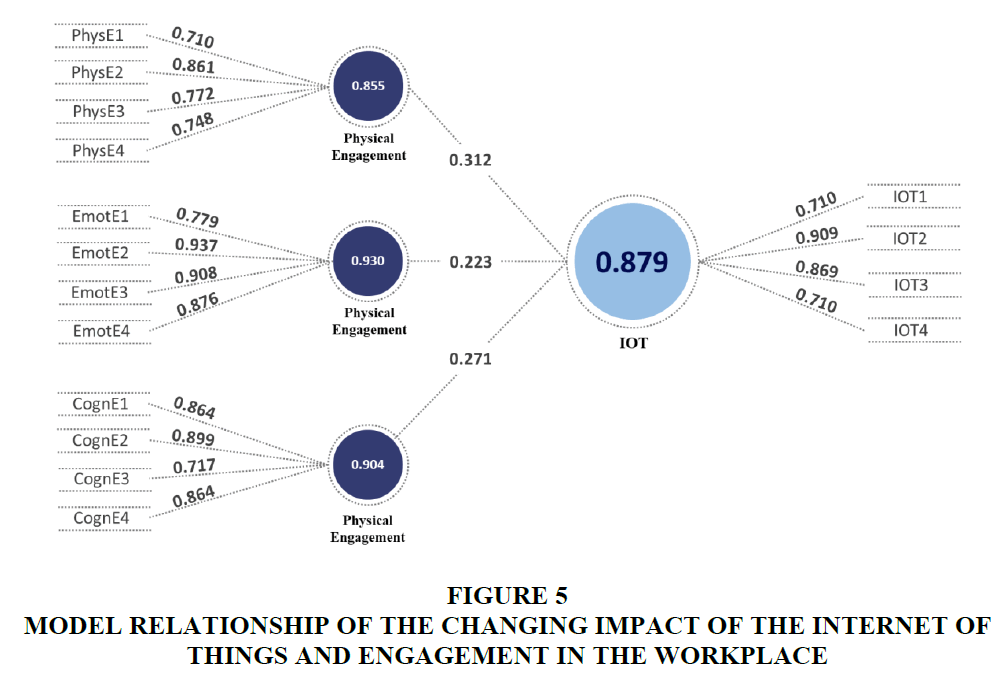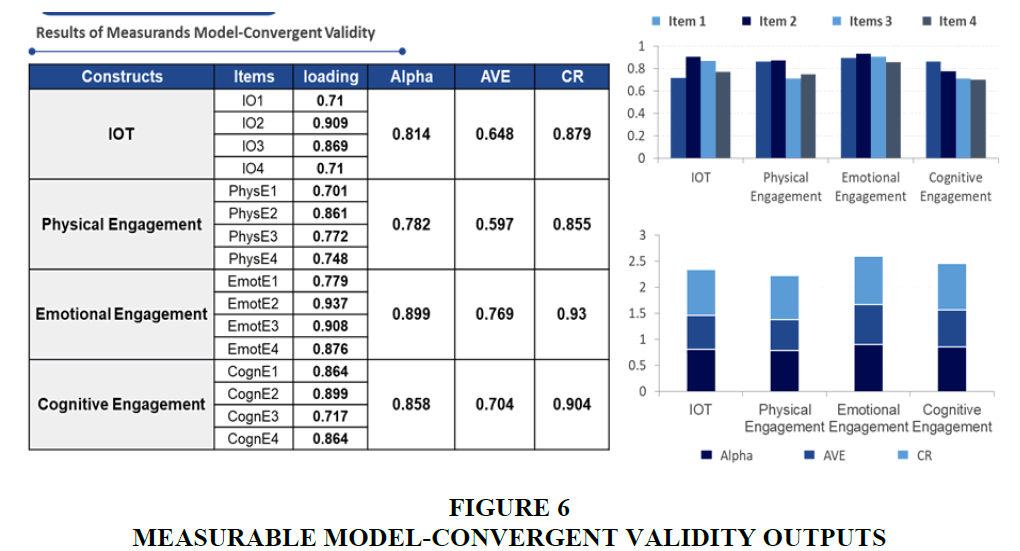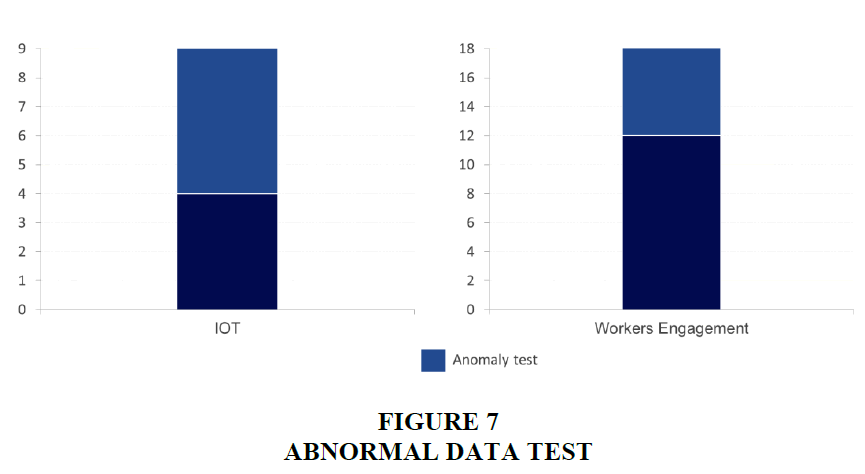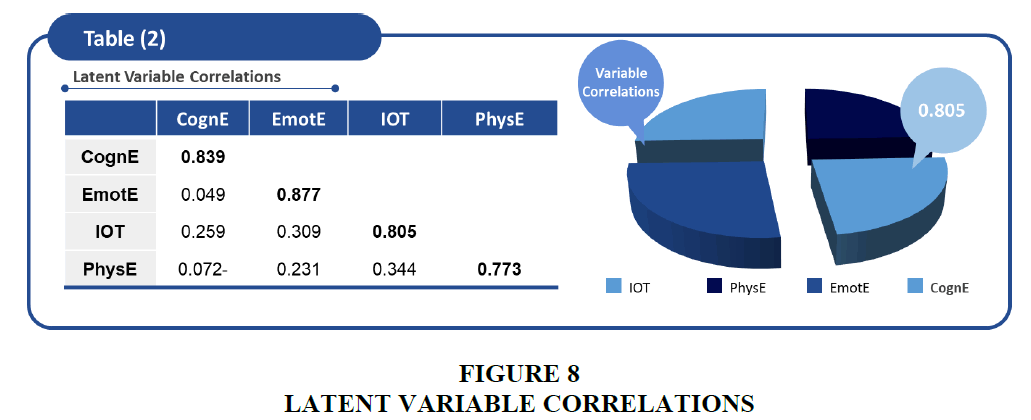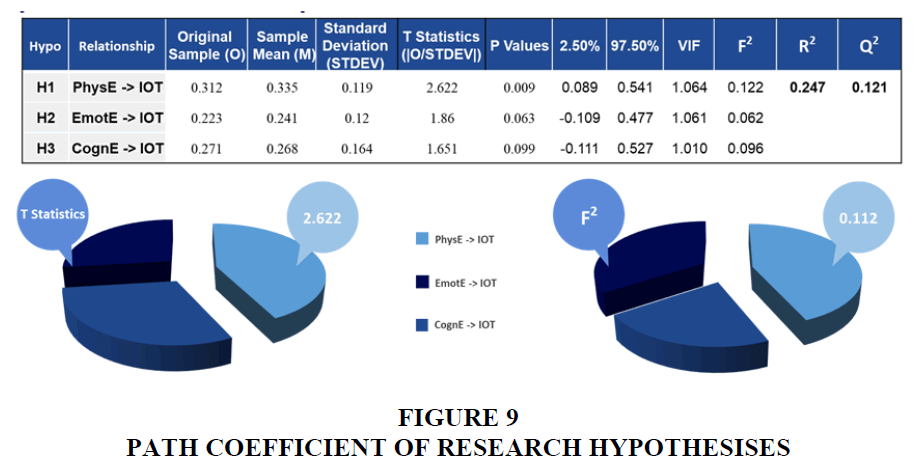Research Article: 2022 Vol: 25 Issue: 6
Internet of things and workers engagement of Asia Cell Telecommunications Company: Iraq
Baqer Khudair Al-Hadrawi, Al-Furat Al-Awsat Technical University
Ameer Rajeh Jawad, Al-Furat Al-Awsat Technical University
Citation Information: Al-Hadrawi, B.K., & Jawad, A. R. (2022). Internet of things and workers engagement of Asia Cell Telecommunications Company: Iraq. Journal of Management Information and Decision Sciences, 25(6), 1-14.
Abstract
The Internet of Things refers to the network of devices capable of collecting data and sharing it with other devices on the same network. This allows objects to be sensed and controlled remotely through the existing network infrastructure. This provides many opportunities for the seamless integration of employees into companies based on modern technologies. Therefore, the current study aims to show the relationship of the Internet of Things to the involvement of workers in Asia Cell Communications Company- Iraq. The study relied on the descriptive-analytical approach and concluded that the Internet of Things has an impact on Workers' Engagement. Companies that use the Internet of Things in their management are highly productive by increasing the involvement of physical, emotional, and cognitive workers.
Keywords
Internet of Things (IoT); Workers Engagement; Asia Cell Telecommunications Company; Iraq.
Introduction
The technological development witnessed by the world with the launch of the third millennium was called the digital revolution. A significant development followed it in the form and size of communications and networks, which greatly affected the various fields of economic, social, political, and cultural life (Spence et al., 2019). This impact has extended to companies as it has become an opportunity and a threat simultaneously, as this business field provides new opportunities for business expansion, facilitation, and cost reduction. And that is by taking advantage of technology. On the other hand, failure to take advantage of those advantages could constitute a loss of companies' competitive position or sales volume. This development in business has become a catalyst for change in the new business world. Investing its employees and keeping pace with it to take advantage of its advantages in improving performance and staying in the competition. There is urgent to know how companies prepare to enter and engage in electronic business. To strengthen its position in the local and international markets, especially since many companies in developing countries are still working away from this new field of business (Spence et al., 2019). The importance of the current study is reflected in the scarcity of studies that tried to diagnose and know the nature of the relationship between the study variables (Internet of things and employee involvement). When workers enter a state of inactivity, their focus becomes outside the company's boundaries. They aim to maintain their work with the least possible effort as they carry out their tasks without rushing. They feel dissatisfied with the environment in which they work, and they do not take additional initiatives such as staying at work for more than the specified time if necessary or help colleagues in their tasks, and they may work to procrastinate regular tasks until they become urgent, cooperate with the team to the minimum, do not make suggestions to improve work and do not discuss the suggestions of others, and other unproductive matters. This leads to poor productivity and losses in achieving the company's goals. Therefore, the problem of the current study lies in the following question: What is the effect of the Internet of Things on the involvement of workers in Asia Cell Communications Company: Iraq? The current study came to lay the correct and appropriate foundations for tackling a real problem that directly affects the telecommunications sector in Iraq.
Literature Review
Internet of Things (IoT)
The concept of the "Internet of Things" originated in 1999 by British researcher (Kevin Ashton) from the Institute (MIT), a concept that studies how to connect things to the Internet through RFID), Wi-Fi, G5 (Bhatt & Chakraborty, 2021) (The Internet of Things technology is one of the most popular technologies in the field of information and communication technology because of its developmental method for systems and societies (Mitchell, 2021). The infrastructure of the Internet of things is still in its infancy. Still, it is developing very quickly, especially in the field of business management (Jha & Khanna, 2020). As IoT solutions are required from all market segments across all functions, it is necessary now and, in the future, to align different business functions with IoT technology (Dimitrov, 2016). Participation of employees, as there is a growing awareness of improving Workers' Engagement, is central to successful trade and business (Lee & Lee, 2015).
The employee engaged in job involvement is the backbone of good work environments, characterized by ethics, diligence, and compliance with the laws and regulations that manage the work today (Figure 1), companies offer many industries that the labor market needs, as these industries need an active work environment that keeps pace with the rapid changes in digital technologies (Gubbi et al., 2013).
The Internet of Things plays a major role in the dynamic change of the work environment to keep pace with the rapid changes in the labor market (Al-Hadrawi & Jawad, 2022). Much attention has been paid to the company's employees and its connection to the Internet of Things. Among these issues is the dependence on the Internet of things inside the organization and its possible advantages and downsides, as well as a recommendation for a new business strategy in light of the Internet of Things (Rose et al., 2015). Given that the Internet of Things is a technical innovation generally accepted within the company, the next step must be to enhance the engagement of employees within the company (Holler et al., 2014). Enhancing Worker's Engagement in light of the Internet of Things improves productivity and regulates the relationship between internal and external factors, such as partners, customers, and workers. This is one of the important issues that IoT-enabled systems focus on (Manavalan & Jayakrishna, 2019) (Figure 2). Oriwoh et al. (2013) describes the Internet of Things as the digital interconnection of devices, people, and various tasks, including sensing, communication, data collection, and identification (Oriwoh et al., 2013).
This means that old non-digital devices are added to digital technology to become digital, such as clothes, household appliances, and bicycles. While Patel & Patel (2016) describes the Internet of Things as the Internet of three things, from people to people, from people to machine/things, and from things/machine to things/machine (Patel & Patel, 2016). Oriwoh et al. (2013) describe the Internet of Things as the digital interconnection of many people, machines, and things for multiple purposes such as sensing, identification, data collection, and communication. The Internet of Things is defined as: "the interconnection between devices at one time and in one place to collect data and use it to improve, control, and predict systems" (Chuang et al., 2020). The Internet of Things is the basis of the Fourth Industry, as there will be approximately 43 billion devices on the Internet of Things by 2023 (Philip et al., 2021). While the first Industry was described as dependent on mechanical production, the second was on the use of electric energy, and the third on automated production (Radanliev et al., 2020). With this rapidly expanding and spreading influence, there are implications for how engagement effectively embraces the IoT and how the IoT can shape engagement itself (Ahmadi et al., 2019). The Internet of Things has been heralded as essential to corporate innovation, adaptation, and success. Especially for companies with large amounts of connectivity, network, and data that share CRM, alliances, joint ventures, and partnerships (Ma et al., 2022). The continuous growth of the Internet of Things raises significant challenges (privacy, security, trust, etc.). Thus, there are concerns about information privacy, identification of potential problems related to data protection, and the shift to automation (Alaba et al., 2017), where the concept of the Industrial Internet of Things (IIoT) has emerged, which provides new opportunities to address security and privacy threats that do not Firms can address it with current business models (Boyes et al., 2018). The heavy use of electronic devices connected to the Internet has enhanced Workers Engagement in the company by effectively exchanging information and expertise. On the other hand, the company must manage these networks effectively to sustain the relationship between employees and the company (Ajibola et al., 2021).
Workers Engagement
The term's origin dates back to as early as the beginning of 1921 in the studies conducted on the morale or readiness of a group of individuals to achieve the company's goals. The American army contributed to the maturation of the idea of the moral value of companies during the Second World War to predict the unity of effort and the readiness of the army forces to go to any extent to achieve prosperity (Homann et al., 2022). After the positive psychology movement, researchers began to investigate the role of positive emotions to enhance exceptional performance. The role of positive emotions on productivity and innovation was demonstrated theoretically and empirically (Andrew & Sofian, 2012). The researcher (Khan) 1990 was the first to put the principle of Engagement, which means the psychological presence of the worker when carrying out his tasks in the company. Also (Khan) tried to discover the basic psychological conditions to justify a moment of individual contracts and the individual separation of service workers for various conditions of work (Rasli et al., 2012). There was a need to find a term to describe the emotional connection of employees to the company and their other partners to work. This need gave birth to the term "Engagement of workers." Employees who care about the future of the company are ready to invest their efforts in its favor (Ojo et al., 2022). According to several researchers, Workers Engagement represents the level at which the worker integrates with the job he exercises and senses its importance, as it is linked to the mental and emotional aspects at the same time (Pranjic et al., 2022). The preoccupation of workers has been defined by several researchers, including: "the feeling of a vital and effective connection with the activities of workers who see in themselves the ability to deal with work requirements" (James et al., 2011). It was also defined as: "the level of commitment and participation that the worker has, in particular, towards the company and its values" (Andrew & Sofian, 2012). It was also defined as: "the worker's commitment and connection to work and the company" (Sweem, 2008). It was also defined as: "the psychological presence when performing the role at work, and it involves the effective use of cognition, emotions, and behaviors" (Homann et al., 2021). The importance of Workers Engagement lies in the fact that large numbers of busy workers contribute to attracting talented individuals to the company. In contrast, non-absorbed workers will cost the company due to their low productivity in their absence and the costs of attracting and training them (Andrew & Sofian, 2012) of the company and the necessary steps to achieve those goals. (Rasli et al., 2012) There are three main aspects to encouraging Workers' Engagement: the worker's unique personal and psychological experience the employer's ability to create conditions that encourage Workers' Engagement, and interaction between workers at all levels (Ruiz-Frutos et al., 2021). The company also uses Workers Engagement as a tool for strategic partnership in business (Bedarkar & Pandita, 2014). Several studies have shown that some leadership behaviors have a clear relationship with the constants of integration, such as motivation, job satisfaction, and job commitment (Al-Hadrawi & Al-zurfi, 2021), which leads to the integration of employees and their involvement in work (Heisler & Bandow, 2018). It is believed that company leaders who work in clear and transparent ways generate strong engagement with customers and employees as they can help employees know how to link strategies for various operations with procedures to build engagement (Stephanie & Gustomo, 2015). The Internet of things plays an important role in ensuring Workers' Engagement. The worker needs clear communication with his superiors to link his role with the leadership's vision, and poor communication hinders Worker's Engagement (Dyląg et al., 2013). The work-life balance has emerged as an important driver of Workers' Engagement, as the balance between them in its broadest sense is defined as an acceptable level of participation in multiple roles in an individual's life. The worker's ability to find time for his work and his family was a decisive factor in his performance at work (De Kervenoael et al., 2020) (Figure 3).
For this reason, great attention has been paid to linking employees' spending with the financial results of companies, as many studies have noted that employee spending leads to more Job performance and enhancement through employee loyalty, retention, and business success (Bedarkar & Pandita, 2014). The employees' Engagement has three dimensions: cognitive Engagement, emotional Engagement, and physical Engagement (Rich et al., 2010) which follows:
Physical Engagement
From a physical (physical) point of view, Engagement means directing the material energies of the individual toward the completion of a specific task, and that material Engagement ranges between passive and active involvement (Castro et al., 2016).
Emotional Engagement
Emotional Engagement means that there is a strong relationship between the emotions, thoughts, and feelings of the individual, and the job (Black et al., 2017), which leads to feelings of enthusiasm and pride (Vallieres et al., 2017). In contrast to emotional Engagement, the concept of "conscious absence" (Johnson et al., 2017), which is characterized by the separation of emotion with others, emerges. In this sense, emotional Engagement is the opposite of the element of "irony" (Whiteoak & Mohamed, 2016).
Cognitive Engagement
Cognitively, individuals are fully immersed in their work practice (Rajan & GD, 2021). The engrossed individuals can ignore the fun of competition and focus intensely on the task given to them (Ni et al., 2021).
From the above, it is possible to formulate the hypotheses of the study and the like:
H1: There Is a Positive, Statistically Significant Relationship Between the Internet of Things and The Physical Engagement of The Asia Cell Telecommunications Company Workers.
H2: There Is a Positive, Statistically Significant Impact Relationship Between the Internet of Things and Emotional Engagement Among the Workers of Asiacell Communications.
H3: There Is a Positive, Statistically Significant Impact Relationship Between the Internet of Things and Cognitive Engagement Among the Workers of Asiacell Communications.
According to the theories of the study, the study outline was carried (Figure 4):
Data and Methodology
Through a survey of the opinions of a sample of employees of the Asia Cell Communications Company, the Najaf office, the questionnaire tool was used to collect the required data by distributing it to the sample members, numbering (71) out of the total number of the study population, which numbered (87). It was found that there was (3) a questionnaire that did not contain complete data, and therefore it was excluded. In addition, the outlier test was conducted, and it was found that (4) outliers and outliers were present. Consequently, it was excluded from the data so that the final sample size was (64) a valid questionnaire for statistical analysis, i.e., at a rate of (90%), which is an acceptable and high percentage. It was analysed using several statistical tests available within the statistical program (SMARTPLS3). The first part of the questionnaire included the personal information of the members of the sample under study (human gender, age group, educational attainment, number of years of service). While the second part was devoted to measuring the Internet of Things variable in the workplace, the scale was developed by (Samhale et al., 2022). It consisted of (9) paragraphs and was developed based on the different environmental conditions and work requirements. The Five-Year Likert Scale was used to measure the phrases. The scale was defined with five answers: (Agree, agree, neutral, disagree, and do not agree at all). The third part was concerned with measuring the employee's consumption variable. The scale that was developed was relied upon by (Rich et al., 2010), which consists of (18) items divided into three dimensions: physical Engagement (6 items), emotional Engagement (6 items), and cognitive Engagement (6 items). Likert quintuple to measure the phrases, and identified with five answers: (agree, agree, neutral, disagree, and do not agree at all). (5 items) were excluded from the Internet of Things scale and (6 items) from the engagement scale because they did not achieve High reliability, and their data were excluded because they are anomalous data based on the Outlier test (Hair et al., 2021).
Working Analysis and Model Building
To identify the validity of the concept, the researchers resorted to calculating the confirmatory factor analysis and building models, which requires that the paragraphs achieve saturations greater than (0.70), as follows:
Variable Internet Model of Things and the Engagement of Workers
The results within Figure 5 and Figure 6 indicate that the data of the variable Internet of things and the use of workers have achieved acceptance of the values of saturation that require to be greater than (0.70), and it is moral at the level (0.05), (Musyaffi et al., 2022) and this indicates that the data achieved structural honesty (Figure 5).
Figure 5 Model Relationship of the Changing Impact of the Internet of Things and Engagement in the Workplace
Scale Stability Test
Although there are several ways and methods to test the scale's stability, the most common method in this field is measuring the extent of the internal consistency of the scale's items using the Cronbach Alpha coefficient. As shown in Figure 6, it is clear that the items were recorded with acceptable stability values more significant than (0.70) and that the scale is stable. Furthermore, there is the convergence between the scales, where it is noted that there is an extent to which the scales are positively related to other measures of the same structure. For example, (0.70) indicates high reliability on all the scales in the study (Musyaffi et al., 2022). The Average Variance Extracted (AVE) was also calculated, which is the external loads that the scale can bear in the study, and it is also called (indicator reliability). The results indicate that the (AVE) is more significant than (0.50), as the measures that achieved a value less than (0.50) were excluded and considered anomalous data Figure 6.
Outlier Test
To test the anomalous or biased data to exclude it, the Outlier test was relied upon. The Outlier test results indicate that there are a number of anomalous and biased items which must be deleted for the data to be suitable for statistical analysis, as shown in Figure 7.
The Latent Variable Correlations of the Measurement Model
When evaluating the measurement model's differential validity, the most critical criteria are relied upon to verify that the indicators used to measure one latent variable do not measure another (Larcker Fornell Henseler et al., 2015). The table presents the results of the Larcker Fornell criterion evaluation, as all the criteria values are higher than the correlations of these combinations with other latent variables in the model, which indicates that all the combinations in the scales are valid (Figure 8).
Cross Loading
It is the process of calculating the extent to which the variables overlap in the model and the extent to which the measures in the model fit with each other Table 1. Where the data indicate no overlap between the study variables, it is noticed that the values of each scale are higher than 0.70 compared itself. Much less than 0.70 compared to the other scales, which indicates that the overlap between the variables is very weak or non-existent due to the presence of negative values (Musyaffi et al., 2022).
| Table 1 Discriminant Validity-Cross Loading | |||||
| Variables | Scales | IoT | Physical Engagement | Emotional Engagement | Cognitive Engagement |
| IoT | I could use the IoT in my Workplace | 0.710 | 0.254 | 0.127 | 0.177 |
| If I have a clear conception of the functionality of the IoT in my Workplace | 0.909 | 0.338 | 0.305 | 0.218 | |
| If I believe it is risk-free to use the IoT in my Workplace | 0.869 | 0.317 | 0.163 | 0.142 | |
| If it is safe to use the IoT in my Workplace | 0.710 | 0.197 | 0.346 | 0.276 | |
| Physical Engagement | I work with intensity on my job | 0.184 | 0.701 | 0.014 | 0.26- |
| I exert my full effort to my job | 0.371 | 0.861 | 0.257 | 0.201 | |
| I devote a lot of energy to my job | 0.209 | 0.772 | 0.169 | 0.143- | |
| lot of energy on my job | 0.235 | 0.748 | 0.207 | 0.226- | |
| Emotional Engagement | I am enthusiastic in my job | 0.225 | 0.1- | 0.779 | 0.06 |
| I am enthusiastic in my job | 0.36 | 0.277 | 0.937 | 0.084 | |
| I am enthusiastic in my job | 0.229 | 0.338 | 0.908 | 0.005- | |
| I am excited about my job | 0.227 | 0.256 | 0.876 | 0.01 | |
| Cognitive Engagement | At work, my mind is focused on my job | 0.225 | 0.009- | 0.084- | 0.864 |
| At work, I pay a lot of attention to my job | 0.256 | 0.051- | 0.085 | 0.899 | |
| At work, I am absorbed by my job | 0.165 | 0.109- | 0.15 | 0.717 | |
| At work, I concentrate on my job | 0.213 | 0.088- | 0.038 | 0.864 | |
Results and Discussion
Testing the Impact Relationships between Variables
This paragraph includes testing the influence relationships between the variables. The researchers adopted the linear regression method to determine the relationship between the variables and test their significance as follows:
The First Main Hypothesis Test (H1)
The analysis results indicate a significant positive relationship between the Internet of Things and the physical Engagement among the workers of the Asia Cell Communications Company, as the value of t statistics reached (2.622). And the value of the regression slope that reflects the beta influence ability amounted to (0.312), and the significance of the relationship was achieved according to the value of the statistic (F), which was (0.122), which is higher than the tabular value. Also, the value of R2=0.247, which means that the variable PhysE explains 25% of the IoT variable, which is an average value because it is less than 50%. Also, when calculating the values of the predictive fit: (Q2) To judge the extent of the predictive suitability of the variables, the research model looks at the value of (Q2) as it is more significant than (0) and indicates that the variables (IOT, PhysE) together are suitable for them. And if this shows something, it shows the precise relationship between the Internet of things and physical Engagement in the workplace. From here, we infer the verification of this hypothesis (Figure 9).
Second Key Hypothesis Test (H2)
The analysis results indicate a positive, significant effect relationship between the Internet of Things and emotional Engagement among the workers of the Asia Cell Communications Company. The value of the T statistics reached (1.860) and the value of the regression slope that reflects the beta impact ability amounted to (0.223), and the significance of the relationship has been it was achieved according to the value of his statistic (F), which was (0.062). If this indicates anything, it shows the precise relationship between the Internet of things and emotional Engagement in the workplace, and from here, we infer the verification of this hypothesis (Figure 9).
The Third Critical Hypothesis Test (H3)
The analysis results indicate a significant positive relationship between the Internet of Things and the cognitive Engagement among the workers of the Asia Cell Communications Company, as the value of T statistics reached (1.651). And the value of the regression slope that reflects the beta influence ability was (0.271), and the significance of the relationship was achieved according to the value of the statistic (F), which was (0.096). And if this indicates something, it only shows the apparent relationship between the Internet of things and cognitive Engagement in the workplace. From here, we infer the verification of this hypothesis (Figure 9).
Conclusion
The current study dealt with the relationship between the Internet of things and the Workers Engagement in Asia Cell Telecom: Iraq. The study results show a close relationship between the Internet of things and Workers' Engagement in the sample under study, as companies that use the Internet of Things in their management are highly productive by increasing the involvement of physical, cognitive, and emotional workers. One of the most prominent advantages of the Internet of Things within the company is the speed and ease of use of the devices used within it. This is what has been proven in this study, where it was noted that there is a strong relationship between the Internet of things and the physical Engagement of workers. It indicates that the variables under study are appropriate for them and that the relationship between them is clear. One of the most important goals of applying successful management methods is to manage the relationship between the company and its employees, and not only that but also to maintain a close relationship with the employees. This is what the Internet of things provides within the company, as the results show that the use of the Internet of items within the company increases the emotional engagement of employees and thus develops the overall productivity of employees. The results also showed that the Internet of Things increases the cognitive Engagement of employees within the company by immersing the worker in his work, ignoring the fun of competition, and being interested in the task entrusted to him.
References
Ahmadi, H., Arji, G., Shahmoradi, L., Safdari, R., Nilashi, M., & Alizadeh, M. (2019). The application of internet of things in healthcare: a systematic literature review and classification. Universal Access in the Information Society, 18(4), 837-869.
Indexed at, Google Scholar, Cross Ref
Ajibola, Y., Daud, R., & Hammons, R. (2021). Best Practices for Community Engagement in Smart Cities. IEEE Technology Policy and Ethics, 6(6), 1-4.
Indexed at, Google Scholar, Cross Ref
Alaba, F.A., Othman, M., Hashem, I.A.T., & Alotaibi, F. (2017). Internet of Things security: A survey. Journal of Network and Computer Applications, 88, 10-28.
Indexed at, Google Scholar, Cross Ref
Al-Hadrawi, B.K., & Jawad, A.R. (2022). The Relationship Between Vitality and Flourishing in the workplace in the Industry 4.0. Journal of Contemporary Issues in Business and Government, 28(3), 890-909.
Al-Hadrawi, B.K., & Al-zurfi, A.R. (2021). Workplace Spirituality, Self-Empowerment and Efficiency: A Religious Perspective. Akkad Journal of Contemporary Management Studies, 1(1), 21-31.
Indexed at, Google Scholar, Cross Ref
Andrew, O., & Sofian. S. (2012). Individual Factors and Work Outcomes of Employee Engagement. Procedia - Social and Behavioral Sciences, 40, 498-508.
Indexed at, Google Scholar, Cross Ref
Bedarkar, M., & Pandita, D. (2014). A study on the drivers of employee engagement impacting employee performance. Procedia-Social and Behavioral Sciences, 133, 106-115.
Indexed at, Google Scholar, Cross Ref
Bhatt, V., & Chakraborty, S. (2021). Improving service engagement in healthcare through internet of things-based healthcare systems. Journal of Science and Technology Policy Management.
Indexed at, Google Scholar, Cross Ref
Black, J.K., Balanos, G.M., & Whittaker, A.C. (2017). Resilience, work engagement and stress reactivity in a middle-aged manual worker population. International Journal of Psychophysiology, 116, 9-15.
Indexed at, Google Scholar, Cross Ref
Boyes, H., Hallaq, B., Cunningham, J., & Watson, T. (2018). The industrial internet of things (IIoT): An analysis framework. Computers in industry, 101, 1-12.
Indexed at, Google Scholar, Cross Ref
Castro, M., Rehfeldt, R.A., & Root, W.B. (2016). On the role of values clarification and committed actions in enhancing the engagement of direct care workers with clients with severe developmental disorders. Journal of Contextual Behavioral Science, 5(4), 201-207.
Indexed at, Google Scholar, Cross Ref
Chuang, J.H., Wang, J.H., & Liang, C. (2020). Implementation of Internet of Things depends on intention: Young farmers’ willingness to accept innovative technology. International Food and Agribusiness Management Review, 23(2), 253-265.
Indexed at, Google Scholar, Cross Ref
de Kervenoael, R., Schwob, A., & Chandra, C. (2020). E-retailers and the engagement of delivery workers in urban last-mile delivery for sustainable logistics value creation: Leveraging legitimate concerns under time-based marketing promise. Journal of Retailing and Consumer Services, 54, 102016.
Indexed at, Google Scholar, Cross Ref
Dimitrov, D.V. (2016). Medical internet of things and big data in healthcare. Healthcare Informatics Research, 22(3), 156-163.
Indexed at, Google Scholar, Cross Ref
Dyląg, A., Jaworek, M., Karwowski, W., Kożusznik, M., & Marek, T. (2013). Discrepancy between individual and organizational values: Occupational burnout and work engagement among white-collar workers. International Journal of Industrial Ergonomics, 43(3), 225-231.
Indexed at, Google Scholar, Cross Ref
Gubbi, J., Buyya, R., Marusic, S., & Palaniswami, M. (2013). Internet of Things (IoT): A vision, architectural elements, and future directions. Future generation computer systems, 29(7), 1645-1660.
Indexed at, Google Scholar, Cross Ref
Hair Jr, J.F., Hult, G.T.M., Ringle, C.M., & Sarstedt, M. (2021). A primer on partial least squares structural equation modeling (PLS-SEM). Sage publications.
Heisler, W., & Bandow, D. (2018). Retaining and engaging older workers: A solution to worker shortages in the US. Business Horizons, 61(3), 421-430.
Indexed at, Google Scholar, Cross Ref
Henseler, J., Ringle, C. and Sarstedt, M. (2015). A new criterion for assessing discriminant validity in variance-based structural equation modelling. Journal of The Academy of Marketing Science, 43(1), 115-135.
Indexed at, Google Scholar, Cross Ref
Holler, J., Tsiatsis, V., Mulligan, C., Karnouskos, S., Avesand, S., & Boyle, D. (2014). Internet of things. Academic Press.
Homann, F., Limbert, C., Bell, N., & Sykes, P. (2022). Safety through engaged workers: The link between Safety-II and work engagement. Safety Science, 146, 105521.
Indexed at, Google Scholar, Cross Ref
Homann, F., Limbert, C., Matthews, S., Castaldi, D., & Sykes, P. (2021). Identifying management practices that drive production-line workers’ engagement through qualitative analysis. Journal of Safety Research, 77, 296-310.
Indexed at, Google Scholar, Cross Ref
James, J. B., McKechnie, S., & Swanberg, J. (2011). Predicting employee engagement in an age‐diverse retail workforce. Journal of Organizational Behavior, 32(2), 173-196.
Indexed at, Google Scholar, Cross Ref
Jha, S., & Khanna, P. (2020). Study of enhancing employee engagement at workplace by adopting internet of things. International Journal of Business and Systems Research, 14(3), 341-361.
Indexed at, Google Scholar, Cross Ref
Johnson, S. J., Machowski, S., Holdsworth, L., Kern, M., & Zapf, D. (2017). Age, emotion regulation strategies, burnout, and engagement in the service sector: Advantages of older workers. Revista de Psicología del Trabajo y de las Organizaciones, 33(3), 205-216.
Indexed at, Google Scholar, Cross Ref
Lee, I., & Lee, K. (2015). The Internet of Things (IoT): Applications, investments, and challenges for enterprises. Business horizons, 58(4), 431-440.
Indexed at, Google Scholar, Cross Ref
Ma, C., Lee, C. K. M., Du, J., Li, Q., & Gravina, R. (2022). Work Engagement Recognition in Smart Office. Procedia Computer Science, 200, 451-460.
Indexed at, Google Scholar, Cross Ref
Manavalan, E., & Jayakrishna, K. (2019). A review of Internet of Things (IoT) embedded sustainable supply chain for industry 4.0 requirements. Computers & Industrial Engineering, 127, 925-953.
Indexed at, Google Scholar, Cross Ref
Mitchell, K. (2021). Internet of Things-enabled Smart Devices, Healthcare Body Sensor Networks, and Online Patient Engagement in COVID-19 Prevention, Screening, and Treatment. American Journal of Medical Research, 8(1), 30-39.
Indexed at, Google Scholar, Cross Ref
Musyaffi, A. M., Khairunnisa, H., & Respati, D. K. (2022). konsep dasar structural equation model-partial least square (sem-pls) menggunakan smartpls. Pascal books.
Ni, L., De la Flor, M., Wang, Q., & Romero, V. (2021). Engagement in context: Making meaning of the Latino community health engagement process. Public Relations Review, 47(2), 102036.
Indexed at, Google Scholar, Cross Ref
Ojo, A. O., Fawehinmi, O., & Yusliza, M. Y. (2022). Survey data on the social, personal, and work resources associated with work engagement among knowledge workers in Malaysia amid the COVID-19 pandemic. Data in Brief, 40, 107690.
Indexed at, Google Scholar, Cross Ref
Oriwoh, E., Jazani, D., Epiphaniou, G., & Sant, P. (2013). Internet of things forensics: Challenges and approaches. In 9th IEEE International Conference on Collaborative computing: networking, Applications and Worksharing (pp. 608-615). IEEE.
Indexed at, Google Scholar, Cross Ref
Patel, K. K., & Patel, S. M. (2016). Internet of things-IOT: definition, characteristics, architecture, enabling technologies, application & future challenges. International Journal of Engineering Science and Computing, 6(5), 6122-6131.
Philip, N. Y., Rodrigues, J. J., Wang, H., Fong, S. J., & Chen, J. (2021). Internet of Things for in-home health monitoring systems: current advances, challenges and future directions. IEEE Journal on Selected Areas in Communications, 39(2), 300-310.
Indexed at, Google Scholar, Cross Ref
Pranjic, N., Bislimovska, D., Brborovic, H., Bislimovska-Karadzinska, J., Mijakoski, D., Milosevic, M., ... & Žaja, R. (2022). The relationship between job demands, job engagements, and burnout among healthcare workers during the COVID-19 pandemic. Safety and Health at Work, 13, S209-S209.
Indexed at, Google Scholar, Cross Ref
Radanliev, P., De Roure, D., Page, K., Nurse, J. R., Mantilla Montalvo, R., Santos, O., ... & Burnap, P. (2020). Cyber risk at the edge: current and future trends on cyber risk analytics and artificial intelligence in the industrial internet of things and industry 4.0 supply chains. Cybersecurity, 3(1), 1-21.
Indexed at, Google Scholar, Cross Ref
Rajan, S. G., & GD, B. P. (2021). Searching for answers on dignity, knowledge and engagement in a worker cooperative society. IIMB Management Review, 33(2), 166-176.
Indexed at, Google Scholar, Cross Ref
Rasli, A., Tat, H. H., Chin, T. A., & Khalaf, B. (2012). Employee engagement and employee shareholding program in a multinational company in Malaysia. Procedia-Social and behavioral sciences, 40, 209-214.
Indexed at, Google Scholar, Cross Ref
Rich, B. L., Lepine, J. A., & Crawford, E. R. (2010). Job engagement: Antecedents and effects on job performance. Academy of Management Journal, 53(3), 617-635.
Indexed at, Google Scholar, Cross Ref
Rose, K., Eldridge, S., & Chapin, L. (2015). The internet of things: An overview. The Internet Society (ISOC), 80, 1-50.
Ruiz-Frutos, C., Ortega-Moreno, M., Allande-Cussó, R., Ayuso-Murillo, D., Domínguez-Salas, S., & Gómez-Salgado, J. (2021). Sense of coherence, engagement, and work environment as precursors of psychological distress among non-health workers during the COVID-19 pandemic in Spain. Safety Science, 133, 105033.
Indexed at, Google Scholar, Cross Ref
Samhale, K. (2022). The impact of trust in the internet of things for health on user engagement. Digital Business, 2(1), 100021.
Spence, C., Mancini, M., & Huisman, G. (2019). Digital commensality: Eating and drinking in the company of technology. Frontiers in Psychology, 10, 2252.
Indexed at, Google Scholar, Cross Ref
Stephanie, & Gustomo, A. (2015). Proposal to improve employee engagement in PT Maju Sentosa by AON Hewitt model and Mercer model. Procedia-Social and Behavioral Sciences, 169, 363-370.
Indexed at, Google Scholar, Cross Ref
Sweem, S. (2008). Engaging a talent management strategy for the 21st century: A case study of how talent management is defined and initiated. Midwest Academy of management Doctoral student paper.
Vallières, F., McAuliffe, E., Hyland, P., Galligan, M., & Ghee, A. (2017). Measuring work engagement among community health workers in Sierra Leone: Validating the Utrecht Work Engagement Scale. Revista de Psicología del Trabajo y de las Organizaciones, 33(1), 41-46.
Indexed at, Google Scholar, Cross Ref
Whiteoak, J. W., & Mohamed, S. (2016). Employee engagement, boredom and frontline construction workers feeling safe in their workplace. Accident Analysis & Prevention, 93, 291-298.
Indexed at, Google Scholar, Cross Ref
Received: 01-Aug-2022, Manuscript No. JMIDS-22-12405; Editor assigned: 03-Aug-2022, PreQC No. JMIDS-22-12405(PQ); Reviewed: 18-Aug-2022, QC No. JMIDS-22-12405; Revised: 22-Aug-2022, Manuscript No. JMIDS-22-12045(R); Published: 27-Aug-2022
